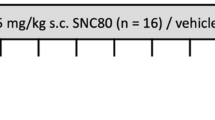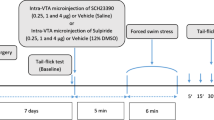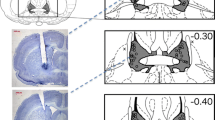Abstract
The olfactory bulbectomized (OB) rat, an animal model of chronic depression with comorbid anxiety, exhibits a profound dysregulation of the brain serotonergic signalling, a neurotransmission system involved in pain transmission and modulation. We here report an increased nociceptive response of OB rats in the tail flick test which is reverted after chronic, but not acute, administration of fluoxetine. Autoradiographic studies demonstrated down-regulation of 5-HT transporters ([3H]citalopram binding) and decreased functionality of 5-HT1A receptors (8-OH-DPAT-stimulated [35S]GTPγS binding) in the dorsal horn of the lumbar spinal cord in OB rats. Acute administration of fluoxetine (5–40 mg/kg i.p.) did not modify tail flick latencies in OB rats. However, chronic fluoxetine (10 mg/kg/day s.c., 14 days; osmotic minipumps) progressively attenuated OB-associated thermal hyperalgesia, and a total normalization of the nociceptive response was achieved at the end of the treatment with the antidepressant. In these animals, autoradiographic studies revealed further down-regulation of 5-HT transporters and normalization in the functionality of 5-HT1A receptors on the spinal cord. On the other hand, acute morphine (0.5–10 mg/kg s.c.) produced a similar analgesic effect in OB and sham and OB rats, and no changes were detected in the density ([3H]DAMGO binding) and functionality (DAMGO-stimulated [35S]GTPγS binding) of spinal μ-opioid receptors in OB rats before and after chronic fluoxetine. Our findings demonstrate the participation of the spinal serotonergic system in the increased thermal nociception exhibited by the OB rat and the antinociceptive effect of chronic fluoxetine in this animal model of depression.




Similar content being viewed by others
References
Adler G, Gattaz WF (1993) Pain perception threshold in major depression. Biol Psychiatry 34:687–689
Ali Z, Wu G, Kozlov A, Barasi S (1996) The role of 5HT3 in nociceptive processing in the rat spinal cord: results from behavioural and electrophysiological studies. Neurosci Lett 208:203–207
Arango V, Underwood MD, Gubbi AV, Mann JJ (1995) Localized alterations in pre- and postsynaptic serotonin binding sites in the ventrolateral prefrontal cortex of suicide victims. Brain Res 688:121–133
Bair MJ, Robinson RL, Katon W, Kroenke K (2003) Depression and pain comorbidity: a literature review. Arch Intern Med 163:2433–2445
Bar KJ, Brehm S, Boettger MK, Boettger S, Wagner G, Sauer H (2005) Pain perception in major depression depends on pain modality. Pain 117:97–103
Bardin L, Malfetes N, Newman-Tancredi A, Depoortere R (2009) Chronic restraint stress induces mechanical and cold allodynia, and enhances inflammatory pain in rat: relevance to human stress-associated painful pathologies. Behav Brain Res 205:360–366
Barnes NM, Sharp T (1999) A review of central 5-HT receptors and their function. Neuropharmacology 38:1083–1152
Bervoets K, Rivet JM, Millan MJ (1993) 5-HT1A receptors and the tail-flick response. IV. Spinally localized 5-HT1A receptors postsynaptic to serotoninergic neurones mediate spontaneous tail-flicks in the rat. J Pharmacol Exp Ther 264:95–104
Bowker RM, Westlund KN, Coulter JD (1981) Origins of serotonergic projections to the spinal cord in rat: an immunocytochemical-retrograde transport study. Brain Res 226:187–199
Burke NN, Hayes E, Calpin P, Kerr DM, Moriarty O, Finn DP, Roche M (2010) Enhanced nociceptive responding in two rat models of depression is associated with alterations in monoamine levels in discrete brain regions. Neuroscience 171:1300–1313
Burke NN, Geoghegan E, Kerr DM, Moriarty O, Finn DP, Roche M (2013) Altered neuropathic pain behaviour in a rat model of depression is associated with changes in inflammatory gene expression in the amygdala. Genes Brain Behav 12:705–713
Castro ME, Diaz A, del Olmo E, Pazos A (2003) Chronic fluoxetine induces opposite changes in G protein coupling at pre and postsynaptic 5-HT1A receptors in rat brain. Neuropharmacology 44:93–101
Castro E, Diaz A, Rodriguez-Gaztelumendi A, Del Olmo E, Pazos A (2008) WAY100635 prevents the changes induced by fluoxetine upon the 5-HT1A receptor functionality. Neuropharmacology 55:1391–1396
Croul S, Sverstiuk A, Radzievsky A, Murray M (1995) Modulation of neurotransmitter receptors following unilateral L1-S2 deafferentation: NK1, NK3, NMDA, and 5HT1A receptor binding autoradiography. J Comp Neurol 361:633–644
D’Amato RJ, Largent BL, Snowman AM, Snyder SH (1987) Selective labeling of serotonin uptake sites in rat brain by [3H]citalopram contrasted to labeling of multiple sites by [3H]imipramine. J Pharmacol Exp Ther 242:3643–3671
Delgado PL, Moreno FA (2000) Role of norepinephrine in depression. J Clin Psychiatry 61(Suppl 1):5–12
Dharmshaktu P, Tayal V, Kalra BS (2012) Efficacy of antidepressants as analgesics: a review. J Clin Pharmacol 52:6–17
Diaz A, Pazos A, Florez J, Ayesta FJ, Santana V, Hurle MA (2002) Regulation of mu-opioid receptors, G-protein-coupled receptor kinases and beta-arrestin 2 in the rat brain after chronic opioid receptor antagonism. Neuroscience 112:345–353
Dickens C, McGowan L, Dale S (2003) Impact of depression on experimental pain perception: a systematic review of the literature with meta-analysis. Psychosom Med 65:369–375
Eide PK, Hole K (1993) The role of 5-hydroxytryptamine (5-HT) receptor subtypes and plasticity in the 5-HT systems in the regulation of nociceptive sensitivity. Cephalalgia 13:75–85
Fields HL, Basbaum AI (1999) Central Nervous System mechanisms of pain modulation. In: Wall PD, Melzack R (eds) Textbook of pain, 4th edn. Churchill Livingstone, Edinburgh, Scotland, pp 309–329
Gabilondo AM, Meana JJ, Garcia-Sevilla JA (1995) Increased density of mu-opioid receptors in the postmortem brain of suicide victims. Brain Res 682:245–250
Gambassi G (2009) Pain and depression: the egg and the chicken story revisited. Arch Gerontol Geriatr 49(Suppl 1):103–112
Gardier AM, Malagie I, Trillat AC, Jacquot C, Artigas F (1996) Role of 5-HT1A autoreceptors in the mechanism of action of serotoninergic antidepressant drugs: recent findings from in vivo microdialysis studies. Fundam Clin Pharmacol 10:16–27
Gonzalez-Maeso J, Rodriguez-Puertas R, Meana JJ, Garcia-Sevilla JA, Guimon J (2002) Neurotransmitter receptor-mediated activation of G-proteins in brains of suicide victims with mood disorders: selective supersensitivity of alpha(2A)-adrenoceptors. Mol Psychiatry 7:755–767
Gormsen L, Ribe AR, Raun P, Rosenberg R, Videbech P, Vestergaard P, Bach FW, Jensen TS (2004) Pain thresholds during and after treatment of severe depression with electroconvulsive therapy. Eur J Pain 8:487–493
Gross-Isseroff R, Dillon KA, Israeli M, Biegon A (1990) Regionally selective increases in mu opioid receptor density in the brains of suicide victims. Brain Res 530:312–316
Grung M, Skurtveit S, Aasmundstad TA, Handal M, Alkana RL, Mørland J (1998) Morphine-6-glucuronide-induced locomotor stimulation in mice: role of opioid receptors. Pharmacol Toxicol 82:3–10
Hache G, Guiard BP, Le Dantec Y, Orvoën S, David DJ, Gardier AM, Coudoré F (2012) Antinociceptive effects of fluoxetine in a mouse model of anxiety/depression. NeuroReport 23:525–529
Hebert C, Habimana A, Elie R, Reader TA (2001) Effects of chronic antidepressant treatments on 5-HT and NA transporters in rat brain: an autoradiographic study. Neurochem Int 38:63–74
Hirsch JD (1980) Opiate and muscarinic ligand binding in five limbic areas after bilateral olfactory bulbectomy. Brain Res 198:271–283
Hjorth S, Bengtsson HJ, Kullberg A, Carlzon D, Peilot H, Auerbach SB (2000) Serotonin autoreceptor function and antidepressant drug action. J Psychopharmacol 14:177–185
Holmes PV (1999) Olfactory bulbectomy increases prepro-enkephalin mRNA levels in the ventral striatum in rats. Neuropeptides 33:206–211
Jacobs BL, Azmitia EC (1992) Structure and function of the brain serotonin system. Physiol Rev 72:165–229
Jeong CY, Choi JI, Yoon MH (2004) Roles of serotonin receptor subtypes for the antinociception of 5-HT in the spinal cord of rats. Eur J Pharmacol 502:205–211
Kelly JP, Wrynn AS, Leonard BE (1997) The olfactory bulbectomized rat as a model of depression: an update. Pharmacol Ther 74:299–316
King TE, Joynes RL, Grau JW (1997) Tail-flick test: II. The role of supraspinal systems and avoidance learning. Behav Neurosci 111:754–767
Klauenberg S, Maier C, Assion HJ, Hoffmann A, Krumova EK, Magerl W, Scherens A, Treede RD, Juckel G (2008) Depression and changed pain perception: hints for a central disinhibition mechanism. Pain 140:332–343
Lautenbacher S, Krieg JC (1994) Pain perception in psychiatric disorders: a review of the literature. J Psychiatr Res 28:109–122
Liang J, Yu S, Dong Z, Wang X, Liu R, Li Z (2011) The effects of OB-induced depression on nociceptive behaviors induced by electrical stimulation of the dura mater surrounding the superior sagittal sinus. Brain Res 1424:9–19
Linge R, Pazos A, Diaz A (2013) Social isolation differentially affects anxiety and depressive-like responses of bulbectomized mice. Behav Brain Res 245:1–6
Lowther S, De Paermentier F, Cheetham SC, Crompton MR, Katona CL, Horton RW (1997) 5-HT1A receptor binding sites in post-mortem brain samples from depressed suicides and controls. J Affect Disord 42:199–207
Malison RT, Price LH, Berman R, van Dyck CH, Pelton GH, Carpenter L, Sanacora G, Owens MJ, Nemeroff CB, Rajeevan N, Baldwin RM, Seibyl JP, Innis RB, Charney DS (1998) Reduced brain serotonin transporter availability in major depression as measured by [123I]-2 beta-carbomethoxy-3 beta-(4-iodophenyl)tropane and single photon emission computed tomography. Biol Psychiatry 44:1090–1098
Mann JJ, Malone KM (1997) Cerebrospinal fluid amines and higher-lethality suicide attempts in depressed inpatients. Biol Psychiatry 41:162–171
Mar A, Spreekmeester E, Rochford J (2002) Fluoxetine-induced increases in open-field habituation in the olfactory bulbectomized rat depend on test aversiveness but not on anxiety. Pharmacol Biochem Behav 73:703–712
Merskey H (1965) The effect of chronic pain upon the response to noxious stimuli by psychiatric patients. J Psychosom Res 8:405–419
Mico JA, Ardid D, Berrocoso E, Eschalier A (2006) Antidepressants and pain. Trends Pharmacol Sci 27:348–354
Millan MJ (1999) The induction of pain: an integrative review. Prog Neurobiol 57:1–164
Millan MJ (2002) Descending control of pain. Prog Neurobiol 66:355–474
Mochizucki D (2004) Serotonin and noradrenaline reuptake inhibitors in animal models of pain. Hum Psychopharmacol 19(Suppl 1):S15–S19
Nadgir SM, Malviya M (2008) In vivo effect of antidepressants on [3H] paroxetine binding to serotonin transporters in rat brain. Neurochem Res 33:2250–2256
Norman GJ, Karelina K, Morris JS, Zhang N, Cochran M, DeVries AC (2010a) Social interaction prevents the development of depressive-like behavior post nerve injury in mice: a potential role for oxytocin. Psychosom Med 72:519–526
Norman GJ, Karelina K, Zhang N, Walton JC, Morris JS, Devries AC (2010b) Stress and IL-1beta contribute to the development of depressive-like behavior following peripheral nerve injury. Mol Psychiatry 15:404–414
Ortega-Alvaro A, Acebes I, Saracibar G, Echevarria E, Casis L, Mico JA (2004) Effect of the antidepressant nefazodone on the density of cells expressing mu-opioid receptors in discrete brain areas processing sensory and affective dimensions of pain. Psychopharmacology 176:305–311
Oyama T, Ueda M, Kuraishi Y, Akaike A, Satoh M (1996) Dual effect of serotonin on formalin-induced nociception in the rat spinal cord. Neurosci Res 25:129–135
Pazos A, Palacios JM (1985) Quantitative autoradiographic mapping of serotonin receptors in the rat brain. I. Serotonin-1 receptors. Brain Res 346:205–230
Pinto-Ribeiro F, Almeida A, Pego JM, Cerqueira J, Sousa N (2004) Chronic unpredictable stress inhibits nociception in male rats. Neurosci Lett 359:73–76
Primeaux SD, Holmes PV (2000) Olfactory bulbectomy increases met-enkephalin- and neuropeptide-Y-like immunoreactivity in rat limbic structures. Pharmacol Biochem Behav 67:331–337
Roche M, Harkin A, Kelly JP (2007) Chronic fluoxetine treatment attenuates stressor-induced changes in temperature, heart rate, and neuronal activation in the olfactory bulbectomized rat. Neuropsychopharmacology 32:1312–1320
Rodriguez-Gaztelumendi A, Rojo ML, Pazos A, Diaz A (2009) Altered CB1 receptor-signaling in prefrontal cortex from an animal model of depression is reversed by chronic fluoxetine. J Neurochem 108:1423–1433
Rojo ML, Rodriguez-Gaztelumendi A, Pazos A, Diaz A (2012) Differential adaptive changes on serotonin and noradrenaline transporters in a rat model of peripheral neuropathic pain. Neurosci Lett 515:181–186
Schwier C, Kliem A, Boettger MK, Bar KJ (2010) Increased cold-pain thresholds in major depression. J Pain 11:287–290
Shi M, Qi WJ, Gao G, Wang JY, Luo F (2010a) Increased thermal and mechanical nociceptive thresholds in rats with depressive-like behaviors. Brain Res 1353:225–233
Shi M, Wang JY, Luo F (2010b) Depression shows divergent effects on evoked and spontaneous pain behaviors in rats. J Pain 11:219–229
Sim LJ, Selley DE, Childers SR (1995) In vitro autoradiography of receptor-activated G proteins in rat brain by agonist-stimulated guanylyl 5′-[gamma-[35S]thio]-triphosphate binding. Proc Natl Acad Sci USA 92:7242–7246
Solomon RE, Gebhart GF (1988) Mechanisms of effects of intrathecal serotonin on nociception and blood pressure in rats. J Pharmacol Exp Ther 245:905–912
Song C, Leonard BE (2005) The olfactory bulbectomised rat as a model of depression. Neurosci Biobehav Rev 29:627–647
Stahl S, Briley M (2004) Understanding pain in depression. Hum Psychopharmacol 19(Suppl 1):S9–S13
Stockmeier CA, Dilley GE, Shapiro LA, Overholser JC, Thompson PA, Meltzer HY (1997) Serotonin receptors in suicide victims with major depression. Neuropsychopharmacology 16:162–173
Stokes PE, Holtz A (1997) Fluoxetine tenth anniversary update: the progress continues. Clin Ther 19:1135–1250
Strigo IA, Simmons AN, Matthews SC, Craig AD, Paulus MP (2008) Increased affective bias revealed using experimental graded heat stimuli in young depressed adults: evidence of “emotional allodynia”. Psychosom Med 70:338–344
Wang W, Wu SX, Wang YY, Liu XY, Li YQ (2003) 5-hydroxytryptamine1A receptor is involved in the bee venom induced inflammatory pain. Pain 106:135–142
Wang W, Qi WJ, Xu Y, Wang JY, Luo F (2010) The differential effects of depression on evoked and spontaneous pain behaviors in olfactory bulbectomized rats. Neurosci Lett 472:143–147
Wang S, Tian Y, Song L, Lim G, Tan Y, You Z, Chen L, Mao J (2012) Exacerbated mechanical hyperalgesia in rats with genetically predisposed depressive behavior: role of melatonin and NMDA receptors. Pain 153:2448–2457
Zeng Q, Wang S, Lim G, Yang L, Mao J, Sung B, Chang Y, Lim JA, Guo G, Mao J (2008) Exacerbated mechanical allodynia in rats with depression-like behavior. Brain Res 1200:27–38
Zhang YQ, Gao X, Ji GC, Huang YL, Wu GC, Zhao ZQ (2002) Expression of 5-HT1A receptor mRNA in rat lumbar spinal dorsal horn neurons after peripheral inflammation. Pain 98:287–295
Zimmermann M (1983) Ethical guidelines for investigations of experimental pain in conscious animals. Pain 16:109–110
Acknowledgments
This work was supported by a grant from the Spanish Government (Ministerio de Ciencia y Tecnología, SAF-2004/00941 and SAF-2007/61862). AR-G was granted a pre-doctoral fellowship from Ministerio de Educación y Ciencia, and MLR was a pre-doctoral fellow from Fundación UPSA.
Conflict of interest
None.
Author information
Authors and Affiliations
Corresponding author
Additional information
Antonio Rodríguez-Gaztelumendi and María Luisa Rojo have contributed equally to this work.
Rights and permissions
About this article
Cite this article
Rodríguez-Gaztelumendi, A., Rojo, M.L., Pazos, Á. et al. An altered spinal serotonergic system contributes to increased thermal nociception in an animal model of depression. Exp Brain Res 232, 1793–1803 (2014). https://doi.org/10.1007/s00221-014-3871-7
Received:
Accepted:
Published:
Issue Date:
DOI: https://doi.org/10.1007/s00221-014-3871-7




